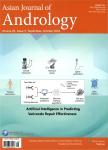Blood-testis barrier and spermatogenesis: lessons From genetically-modified mice
Blood-testis barrier and spermatogenesis: lessons From genetically-modified mice作者机构:Hefei National Laboratory for Physical Sciences at Microscale School of Life Sciences University of Science and Technology of China Hefei China Medical Research Council Human Genetics Unit and Institute of Genetics and Molecular Medicine University of Edinburgh Edinburgh United Kingdom Institute of Physics Chinese Academy of Sciences Hefei China.
出 版 物:《Asian Journal of Andrology》 (亚洲男性学杂志(英文版))
年 卷 期:2014年第16卷第4期
页 面:572-580页
核心收录:
学科分类:0710[理学-生物学] 07[理学] 08[工学] 09[农学] 081304[工学-建筑技术科学] 071007[理学-遗传学] 0901[农学-作物学] 0813[工学-建筑学] 0836[工学-生物工程] 090102[农学-作物遗传育种]
基 金:This work was supported by the National Basic Research Program (Nos. 2013CB947900 2013CB945502 and 2014CB943101) of China (973) by grants from National Natural Science Foundation of China (No. 31371519) and the Knowledge Innovation Program of the Chinese Academy of Sciences (No. KSCX2-EW-R-07)
主 题:blood-testis barrier genetically-modified mouse seminiferous tubule sertoli cells spermatogenesis
摘 要:The blood-testis barrier (BTB) is found between adjacent Sertoli cells in the testis where it creates a unique microenvironment for the development and maturation of meiotic and postmeiotic germ cells in seminiferous tubes. It is a compound proteinous structure, composed of several types of cell junctions including tight junctions (TJs), adhesion junctions and gap junctions (GJs). Some of the junctional proteins function as structural proteins of BTB and some have regulatory roles. The deletion or functional silencing of genes encoding these proteins may disrupt the BTB, which may cause immunological or other damages to meiotic and postmeiotic cells and ultimately lead to spermatogenic arrest and infertility. In this review, we will summarize the findings on the BTB structure and function from genetically-modified mouse models and discuss the future perspectives.




